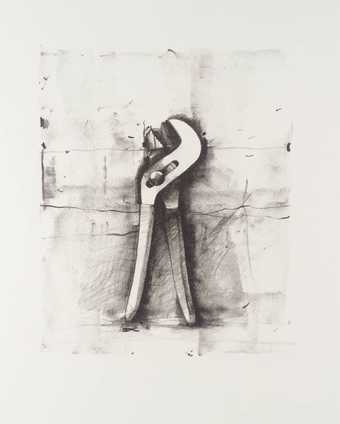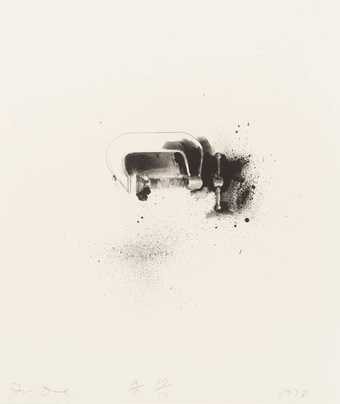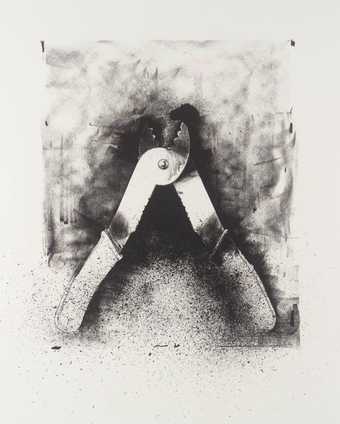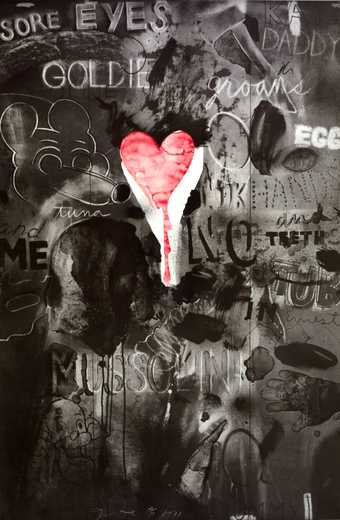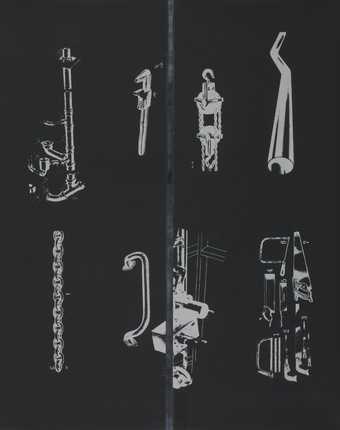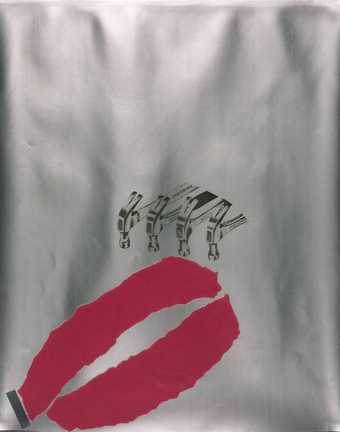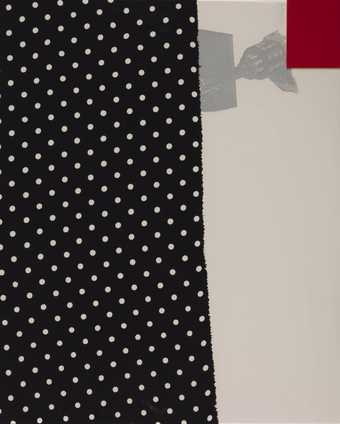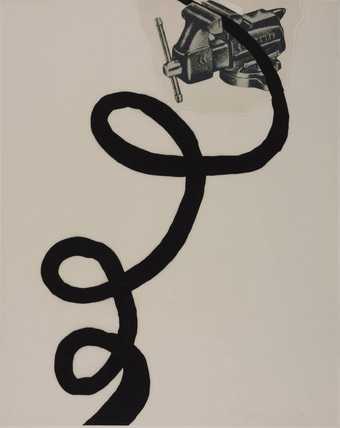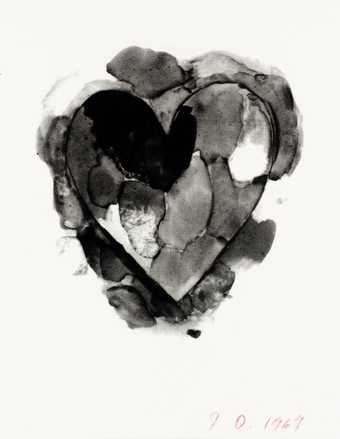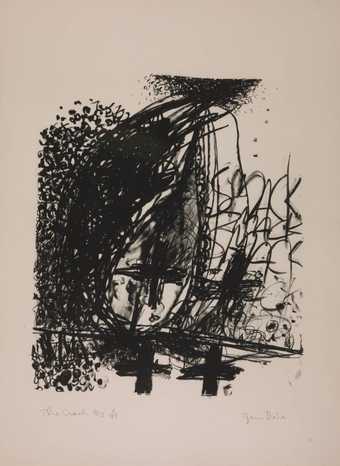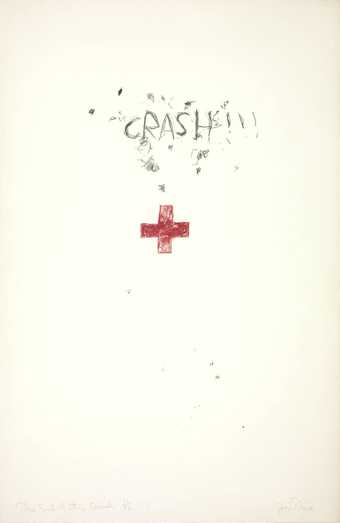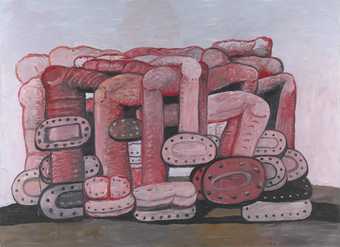
Not on display
- Artist
- Jim Dine born 1935
- Medium
- Oil paint, charcoal and steel on canvas
- Dimensions
- Support: 1524 × 2743 × 29 mm
- Collection
- Tate
- Acquisition
- Purchased 1965
- Reference
- T00761
Summary
Walking Dream with Four Foot Clamp comprises three rectangular canvases across which are shown nineteen pale pink ladies’ legs. These appear in profile against a sketchy grey background, making the image almost monochromatic. The legs on the left-hand and central canvases all point towards the left as though moving in that direction. On the right-hand canvas the legs point in the opposite direction, apart from the only ‘pair’ in the painting, which is seen from the front at the very end of the line and appears stationary. All of the feet are clad in pointed, black heeled shoes, and most of the legs are shown up to mid-thigh height, the level that a 1960s mini-skirt might reach, while pieces of material resembling skirts or trousers are suggested by pencil lines in the grey section above and behind the thighs. A sense of movement is achieved by the profusion of legs, and the repetition of specific styles of shoe implies the legs’ progression across the canvas. The outline of a ceiling light seen from various angles appears in several places across the background. The central canvas projects further out towards the viewer than the other two, being fastened to a slightly deeper support. A clamp is attached to this middle section and a spanner is fixed to the clamp as though the process of assembling the structure might be ongoing, and Dine has painted the shadow of the spanner onto the canvas.
This painting was produced in February 1965 in Dine’s temporary studio at the Chelsea Hotel in New York. The oil paint has been added to the background in large, loose brushstrokes. The overall effect is that of fairly dry paint in opaque greys, applied quickly and with varying density. By comparison, the flesh colour has been applied in thicker, flat areas of paint. These stand out in stark contrast to the background and the more solid black of the shoes. The bedroom light, outline of the legs, shoes, pieces of material and additional lines are drawn in charcoal, giving them their more sketchy appearance.
Walking Dream with Four Foot Clamp was first exhibited in 1965 at the Robert Fraser Gallery in London and appears to pay homage to the city’s centrality to the fashion scene at that time. Other paintings in the show included Dine’s British Joys (A Picture of Mary Quant) 1965 (Becht Collection, Naarden), which includes a pair of crossed legs – possibly those belonging to the fashioner designer mentioned in the title – that are similarly detached from the body. However, Walking Dream with Four Foot Clamp most closely resembles Moving Girls and Dreams 1965 (private collection) and The Sixteen Foot Line 1965 (collection of the artist), both of which were produced with the same materials, colours and technique. In the former the figure is cropped at the neck and the arms are visible, while the latter focuses solely on legs. Art historian Marco Livingstone has proposed that these forms were a development of the puppet-like cardboard figures that Dine used in his live performance The Vaudeville Show 1960 (Livingstone 1998, p.239). More broadly, Dine explained in 1995 that ‘It had to do with isolating objects in space, which has always been, and I don’t know why, my penchant’ (quoted in Livingstone 1998, p.250).
Workman’s tools, such as the spanner seen in this painting, have appeared regularly in Dine’s work since his 1962 Summer Tools (private collection). The artist indicated an interest in the aesthetic nature of these objects, stating in 1999:
A tool can be inspiring. Not just because it’s some sort of phallic symbol, but because this tool is a beautiful object in itself. It has been refined to be an extension of one’s hand, over the centuries, in a process of evolution. And it can inspire you that way.
(Quoted in Celant, Bell and Blaut 1999, p.136.)
Such objects also have autobiographical connotations, as Dine explained in 1980: ‘My father had a store, and I was always in the store when I was a little kid. And I was really bowled over by it, by being there … the objects themselves became things to fix on’ (quoted in Shapiro 1981, p.209).
The artist commented further that the tools in his paintings could be viewed as actors, and the canvas as a stage (Dine in Celant, Bell and Blaut 1999, p.133). As an active participant in the New York art scene from 1958, Dine was also involved in ‘happenings’ – performance pieces which he began in 1991 and based on a lifetime of ‘bad dreams’ (quoted in Celant, Bell and Blaut 1999, p.37) – and there is an element of theatricality in Walking Dream with Four Foot Clamp, in which the legs might be interpreted as those of performers moving on a stage.
Dine’s work was included in the International Exhibition of the New Realists, the showcase of contemporary pop art at the Sidney Janis Gallery, New York, in 1962. However, Dine denied being a pop artist, stating in 1975 ‘I have never been a pop artist … I used [objects] as metaphors and receptacles for my marginal thoughts and feelings’ (quoted in Livingstone 1998, p.15).
Further reading
David Shapiro, Jim Dine: Painting What One Is, New York 1981, reproduced pl.104.
Marco Livingstone, Jim Dine: The Alchemy of Images, New York 1998.
Germano Celant, Clare Bell and Julia Blaut, Jim Dine: Walking Memory, 1959–1969, New York 1999, reproduced, unpaginated.
Lucinda Towler
November 2016
Supported by the Terra Foundation for American Art.
Does this text contain inaccurate information or language that you feel we should improve or change? We would like to hear from you.
Catalogue entry
T00761 Walking Dream with a Four Foot Clamp 1965
Inscribed on reverse of each section 'Walking Dream with a 4 foot Clamp | Jim Dine 1965', and on the middle section also 'N.Y.C.', together with instructions for assembly
Oil and charcoal on canvas, with steel clamp and spanner, in three sections each 60 x 36 (152.5 x 91.5), the centre panel projecting 1 (2.5); overall dimensions 60 x 108 x 1 1/8 (152.5 x 274.5 x 3)
Purchased from the artist through the Robert Fraser Gallery (Grant-in-Aid) 1965
Exh: Jim Dine: Recent Paintings, Robert Fraser Gallery, London, June-July 1965 (12, repr.); Jim Dine, Whitney Museum, New York, February-April 1970 (79, repr.)
Repr: Studio, CLXX, 1965, p.81; Architectural Review, CXXXVIII, 1965, p.202
The artist wrote (1 November 1965) that this picture 'was painted in February of 1965 when I had a temporary studio at the Chelsea Hotel in NYC. It along with the Janis picture called "Moving Girls and Dreams" were part of the group ... shown at Fraser's and were what I was feeling about at the time. It would be rather like "short changing" myself if I didn't use or not use everything that is available to me to make a picture, in this case dreams.' The pictures in this group are thinly painted - almost drawn - and the objects attached to them, often clothes, are not painted. Several have an English reference and most, like T00761, have a grey background and feature the outline of an electric light fitting which hung over Dine's bed. Girl's legs and feet (this was the period of the mini-skirt and stiletto heels) are the main motif of at least two further pictures: '16 Foot Line' and 'Moving Girls and Dreams' (Recent Work by Arman, Dine, Fahlstrom ..., Sidney Janis Gallery, New York, May 1965, nos.5 and 6 repr.), and appear in other related pictures and drawings. In addition, there are several sculptures of 1965 on the theme of boots, such as 'Leg walking through' (I and II) and 'Large Boot lying down.'
Dine's Happening 'Natural History (Dreams)' performed in New York in April 1965 was also concerned with dreams and free-association.
Published in:
Ronald Alley, Catalogue of the Tate Gallery's Collection of Modern Art other than Works by British Artists, Tate Gallery and Sotheby Parke-Bernet, London 1981, pp.173-4, reproduced p.173
Explore
- objects(23,571)
-
- clothing and personal items(5,879)
-
- shoe(179)
- electrical appliances(404)
-
- fan(8)
- tools and machinery(1,287)
- actions: postures and motions(9,111)
-
- walking(607)
- leg(337)
- dreaming(213)
You might like
-
Jim Dine [no title]
1973 -
Jim Dine [no title]
1973 -
Jim Dine [no title]
1973 -
Jim Dine Picabia III (Groans)
1971 -
Jim Dine Tool Box 1
1966 -
Jim Dine Tool Box 2
1966 -
Jim Dine Tool Box 4
1966 -
Jim Dine Tool Box 6
1966 -
Jim Dine Tool Box 8
1966 -
Jim Dine Tool Box 9
1966 -
Jim Dine Four Hearts
1969 -
Jim Dine Welcome Home Rare Birds
1969 -
Jim Dine The Crash #3
1960 -
Jim Dine The End of the Crash
1960 -
Philip Guston Monument
1976

